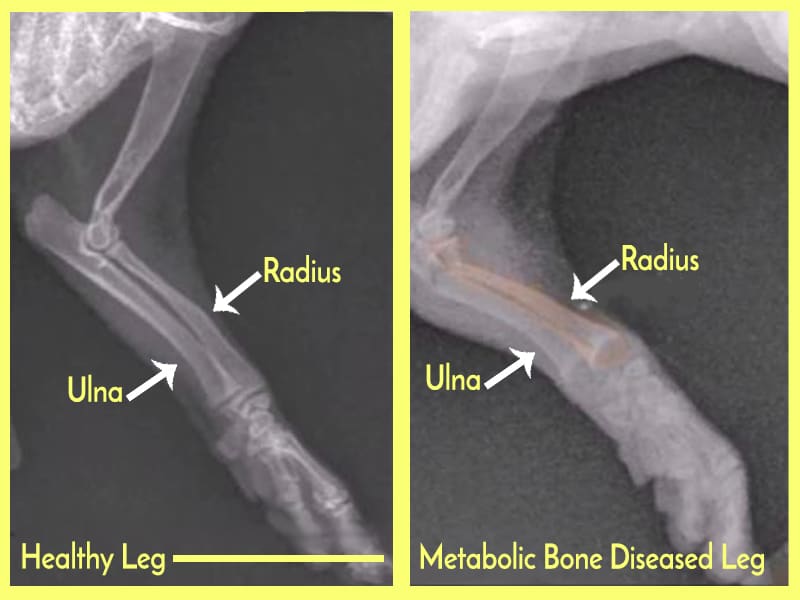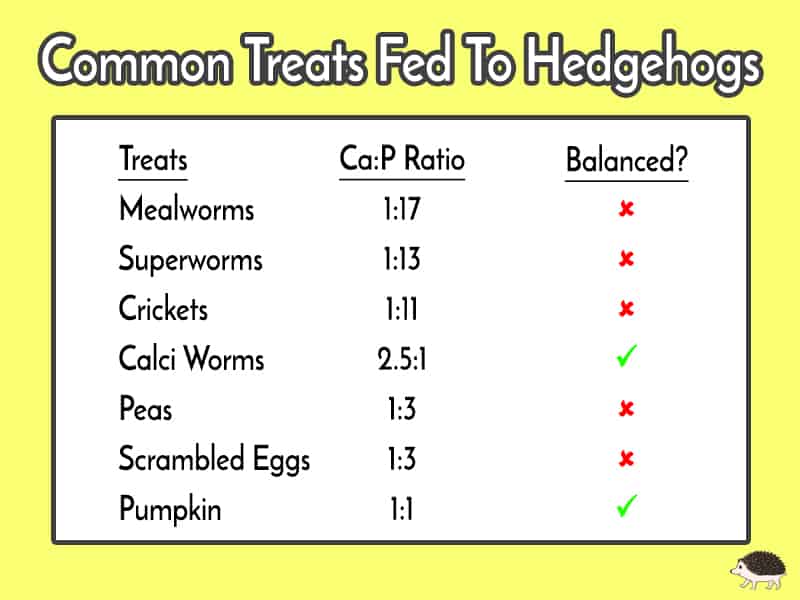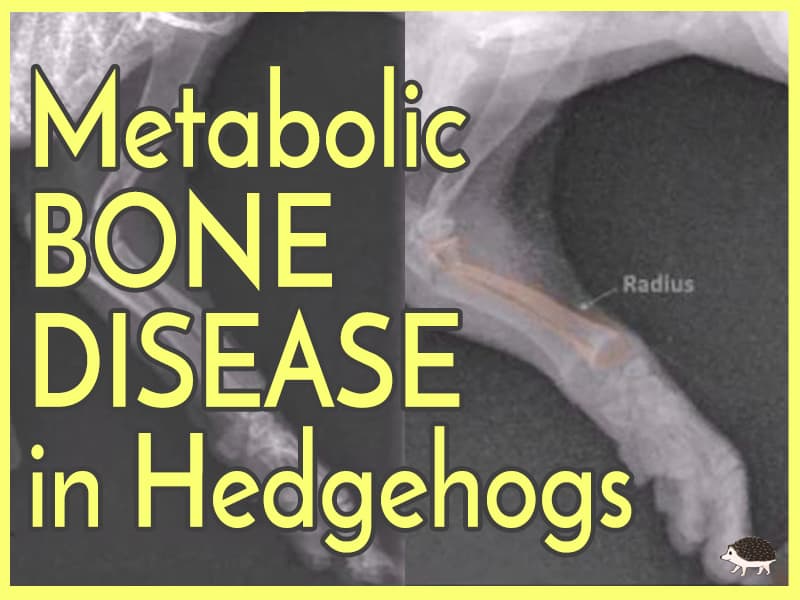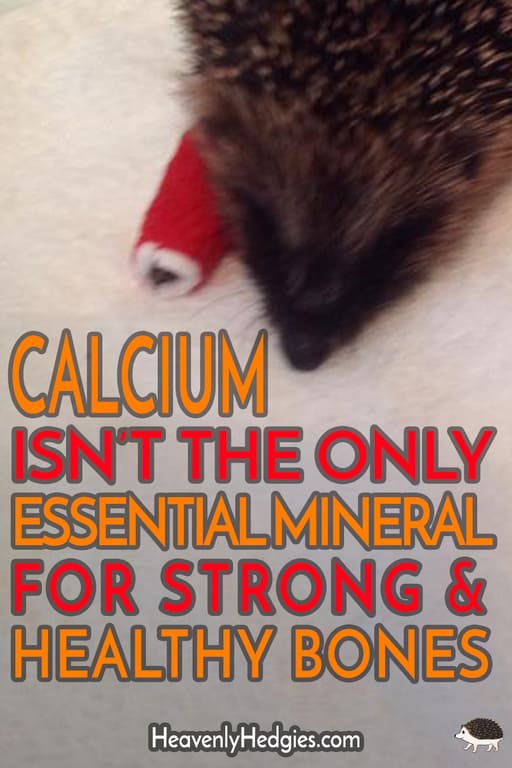Micro fractures, joint abnormalities, weakening bones, reduced movement, inability for blood to clot, and muscle tremors are all symptoms of metabolic bone disease in hedgehogs. To us, it looks a lot like wobbly hedgehog syndrome because it similarly renders their limbs immobile, reduces nerve communication that leads to becoming paralyzed, and increases the risk of seizures. Usually this disease ends in the hedgehog needing to be put down, which increases the urgency for us to find out how we can prevent it and combat it together!
The following information is useful for both wild hedgehogs and domesticated African Pygmies. Our intention is to increase your curiosity as a hog parent about the new information regarding calcium:phosphorus ratios in your hedgehog's regular diet, which we believe is a major contributing factor in hedgehog metabolic bone disease. Just to be clear, this ratio is not the only factor that plays a role in calcium absorption, but has an important role. Before adjusting your hedgehog's diet, we highly recommend that you consult with their veterinarian and get a bone x-ray and blood panel. Too much calcium in a hedgehog's diet can cause other problems such as kidney stones.
AFFILIATE DISCLOSURE: Heavenly Hedgies is an Amazon Associate. We have partnered with them and other reputable merchants when they sell something that we feel will benefit our readers. By purchasing through our links, we may earn a small commission on sales, that helps us continue to provide informative and educational information for hedgie lovers. And the best part is that there is no additional cost to you. Thank you for being a loyal and supportive reader here at Heavenly Hedgies.
How Is Metabolic Bone Disease Diagnosed?

If a hedgehog begins to lose mobility in their legs, especially the hind ones, hedgie owners think wobbly hedgehog syndrome – must be neurological. But, if you read our hedgehog illnesses and symptoms article, you'll remember that other symptoms mimic those of WHS (wobbly hedgehog syndrome). Therefore, an x-ray is really important to assess the condition of your hedgehog's bones. Taking a look at a healthy leg and then a leg with metabolic bone disease (MBD), paints a better picture of what exactly is happening.
The outline of the healthy x-ray bones appears to have a thick white layer. That's because in x-rays, the calcium present in bones absorbs the x-rays the most, making the bones appear white. In the x-ray of the diseased hedgehog, the lines are dim and the bones appear blurred. This is because the hedgehogs bones are becoming soft, and soft tissue absorbs less x-rays making bones that have been depleted of their calcium appear soft and grey. But, MBD is more than a calcium deficiency, it is a metabolic disruption.
How Does Metabolic Bone Disease in Hedgehogs Develop?
It could've been a genetic trait, a malfunctioning metabolic function, or something directly related to an imbalance of calcium to phosphorus ratios in their diet which caused MBD to develop. Calcium is an essential mineral for the formation of healthy bones. Phosphorus is also important for healthy bones plus other things like kidney function, muscles, blood vessel functionality, and heart health. Basically, the two need each other. When both calcium and phosphorus levels are correct, both minerals are able to perform their vital functions. When they're not correct, their bodies try to balance out the levels by stealing calcium from other areas.
Normally, when calcium concentrations in the bone tissue are below their average 2.2 – 2.6 mmol/L, the parathyroid hormone helps bring the range back to normal by decreasing the concentration of phosphate ions in the blood. It does this by taking the calcium from the bones, from the small intestine, and reabsorbs it from their urine. That process leaves their systems imbalanced and vulnerable to illness and harm. Thus, metabolic bone disease is only one of the many other possible illnesses that may arise from a calcium and phosphorus imbalance.
Progression of Metabolic Bone Disease in Hedgehogs
Once their bones begin to be depleted, fractures in the radius and ulna bones occur easily, and the hedgehog is then vulnerable to hyperparathyroidism. Hyperparathyroidism means there is too much of the parathyroid hormone circulating in the blood stream. That's bad because that would mean that the hormone responsible for regulating phosphorus and calcium is not working properly.
The task of trying to self-regulate calcium and phosphorus levels takes quite a toll on the kidney. See, during a calcium imbalance, one of the kidney's tasks is to strip other organs of their calcium so it can create vitamin D. Vitamin D helps the body absorb calcium which is why Vitamin D in their food is really important; especially after the kidneys have turned the vitamin into calcitriol. Calcitriol helps their bellies absorb more calcium into the bloodstream, and prevents the kidneys from losing calcium. Sadly, like we previously mentioned in our illnesses article, a hedgehog's hard working kidneys are a common area to develop cancer, so its a fragile organ to start with and not one we would choose to over burden.
Why Are Phosphorus And Calcium So Important?
So, why are we focusing on phosphorus and calcium again? Because these two work together to create strong and healthy bones in hedgehogs. When that ratio is off, that is when metabolic bone disease in hedgehogs could begin. Their body will strive to fix the imbalance itself. If hedgehogs eat a diet high in phosphorus and low in calcium, then too much phosphate accumulates inside their blood. That leads to insufficient calcium being consumed, thus stripping their bones of precious calcium. If calcium levels in the blood stream are too low, then this could be detrimental. Why? Because their bodies will respond by pulling calcium out of the bones and other organs so it can correct the amount of calcium and phosphorus in the blood stream already.
IS Metabolic Bone Disease in Hedgehogs REVERSIBLE?
It doesn't have to be too late for the metabolic bone disease in hedgehogs to turn around. Once calcium in the bones has been depleted, it cannot be easily reversed. You may try working with your vet to increase their calcium and D3 intake and to balance their calcium to phosphorus intakes during meals. Through change of lifestyle and diet, a hedgehog can, but not always, recover if their conditions have not yet worsened beyond control.
It could take months or a year, so do not expect their metabolisms to become balanced over night, but it is worth a try. The kinks and deformities in their bone and joints most likely will stay, but their ability to heal their own fractures and to maintain calcium again may return.
Easing The Pain
Using an anti-inflammatory, such as hedgehog pet tincture CBD oil drops, can aid in any pain and help reduce daily swelling of damaged joints. We encourage you to read how CBD oil works and whether or not it's safe and effective. Hedgehogs continuing with untreated metabolic bone disease will most likely begin to suffer long lasting painful bone and joint deformity. Because of that, euthanasia may be the kindest decision if x-rays do not show signs of improvement despite their owners attempt at changing lifestyle diet habits. It does become very painful for both the hedgehog and their loving owners. And there's no guarantee that it can be reversed.
What Is A Normal Ca:P Ratio To Feed A Hedgehog?
It is very important to feed a well balanced diet with foods that have a 2:1 or 1:1 calcium to phosphorus ratio. Knowing that, maybe it is time to stop focusing on mainly feeding mealworms and add soldier black fly larvae and other insects to make a balanced mix.
Mealworms can contain 30x more phosphate than calcium giving them a 1:17 Ca:P ratio. But according to our research, they're not the worst insect for imbalanced Ca:P ratios. Hornworms are! In fact, the only worms that are balanced with a low phosphorus content are the calci-worms. These have a 2.5:1 ratio.
How To Make A Balanced Hedgehog Diet Plan
Just because your hedgehog eats it, doesn't mean it's healthy for them. They're opportunistic omnivores after all. It is important to find a balanced quality cat kibble. Then pair it with a healthy treat, and offer a mixture of insects that includes calci-worms that have been gut loaded with broccoli. Broccoli is a great idea to feed the worms because it's rich in folic acid, vitamin K and C, fiber, and potassium. Do you remember what we said in our hedgehog food list article? Your hedgehog does not have the ability to break down nutrients from vegetables and fruits. But the bugs they eat do! When the nutrients are in the bugs stomachs, it is now usable by the hedgehog's digestive system.

Taking a look at a hedgehogs staple diet, their cat food/biscuits should contain a whole meat and other high quality ingredients such as brown rice, added omega-3's, and vitamins like the beneficial D3 and calcium. If you're feeding a high quality cat food, like the one we mention here, it has a 1:1 calcium to phosphorus ratio per tablespoon, plus has the added benefits of D3 and other essential amino acids and minerals. For daily treats, offer a mixture of insects, that includes calci-worm to balance out the high phosphorous in the other insects.
Although popular among many as a feed for their wild hedgies that visit their gardens, mealworms, sunflower hearts, uncooked peas, and peanuts are also among the foods that shouldn't be fed. They have high phosphate and low calcium stats. We know – it is hard to find a cat food without pea fiber, which is why we suggest you find a cat food that has it much lower in its ingredient list.
How Much Phosphorus and Calcium Should They Have?
How much calcium and phosphorus should hedgehogs be expected to have? According to Exotic Animal Medicine, 2015, African Pygmy's need 202 – 206 mmol/L of calcium and 1.6 – 2.1 mmol/L of phosphorus. Their wild cousins, the European hedgehogs, need 3.1 mmol/L calcium and 1.5 mmol/L of phosphorus in their blood.
As you've read, too much or too little of those things causes their metabolisms to get out of whack and start working against them. Your vet or their technician should be able to provide a blood test for you to at least determine what their calcium and phosphorus levels are that day.
Are There Any Safe Ca:P Hedgehog Treats?
There is something causing a stir that you can try and it's called beef tripe. Beef tripe comes from the muscle wall of the bellies of cows. It is perfectly balanced in Ca:P with a 1:1.2 ratio. It is also rich in Omega 3 and 6 fatty acids, contains healthy probiotics, digestive enzymes, and is described as having a mouth watering taste. The product in particular we are talking about can be added into their food mix, or given as individual tiny treats daily. And although freeze dried, it contains enough moisture making it comparable to a quality cat kibble. Check the Ca:P balanced treat idea out here, or click the image below. If you are curious about something before feeding it to your hedgie, check out eatthismuch.com. Take the value of its calcium and divide it by the amount phosphorus per serving.
This is how we calculated the ratio of beef tripe: 81 mg of calcium divided by 66 mg of phosphorus get a fantastic 1.3 : 1. And remember, between 1:1 and 2.5:1 are safe guidelines that need to be followed for African Pygmy hedgehogs. Otherwise, it could lead to metabolic bone disease.
How Do You Calculate Calcium and Phosphorus Per Serving?
To help answer this question, we're going to give an example calculation. We know chicken is a common hedgehog treat, but according to our new research – you may want to avoid feeding baked or broiled chicken and only serve boiled. Why? Because per 1 cup of baked or broiled chicken, there is a 1:16 calcium to phosphorus ratio (300 mg of phosphorus and 21 mg of calcium).
Okay, but we only feed say 2 tablespoons of the chicken to them per day. There are 16 tablespoons in a cup. Now that's 300 mg divided by 16 x 2 = 37.5 mg of phosphorus in 2 tbs of chicken. 21 mg of calcium divided by 16 x 2 = 2.62 mg of calcium in 2 tbs of chicken. Putting those together, we have a 1:14 calcium phosphorus ratio. That's not an ideal number at all. But what if we boil it?
Can Phosphorus Levels In Food Be Reduced?
According to the United States National Library of Medicine, boiling vegetables and meat reduces the phosphorus content. This reduction is proportional to the amount of water used, the size of the pieces, cooking time, and absence of skin. A reduction amount of 38% for meat, 51% vegetables, and 48% for legumes, is not uncommon. Which means, if the peas in our cat foods are boiled, they are no longer that big of a concern – especially when you find boiled peas on the safe end of the US Library of Medicine's phosphorus food pyramid. [source: ncbi.nlm.nih.gov]
Recap: Metabolic Bone Disease In Hedgehogs
Now with your new understanding of how calcium and phosphorus ratios effect bone development and metabolic bone disease in hedgehogs, when someone tells you that feeding mealworms are not a good idea, you'll know why and what that means. In fact, several agencies have begun to warn their audiences about the harmful effects of feeding mealworms, sunflower hearts, and peanuts to wild hedgies. However, these warnings have been rejected because MBD in hedgehogs is hotly debated. And calcium:phosphorus ratios are not just affecting wildlife, it's also a running problem that is still being studied by health professionals in humans.
Calci-worms/black soldier fly larvae are by far the best balanced feeder insect to counteract the higher phosphorous levels of other insects. When you provide an insect mixture with a high quality cat food, like the recommendation above, they should receive most of the necessary nutrients. Always try to check the calcium and phosphorus levels of anything you give hedgehogs using the methods we have shown you. And more of a good thing isn't always better. Remember that balance is key.
If a hedgehog is not receiving the proper amount of calcium and phosphorus, their organs and calcium levels drops. This results in losing bone mass and control over their bodies. Metabolic bone disease in hedgehogs can be prevented or treated (with early intervention). It requires diligence and understanding. We hope we've given you enough information to at least have foundational knowledge to build upon. Remember, what you put into your body is what you get back. And the same goes for your beloved heavenly hedgie!





